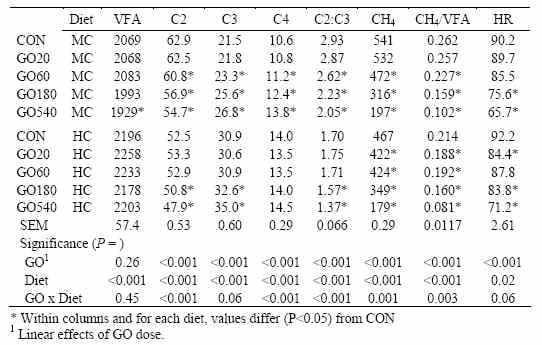Effects of garlic oil on in vitro rumen fermentation and methane production are influenced by the basal diet

Calsamiglia, S., M. Busquet, Cardozo P.W., Castillejos L., and A. Ferret, 2007. Invited Review: Essential oils as modifiers of rumen microbial fermentation. J. Dairy Sci. 90: 2580- 2595.
Demeyer, D.I., 1991. Quantitative aspects of microbial metabolism in the rumen and hindgut. In: Jouany, J.P. (Ed.), Rumen Microbial Metabolism and Ruminant Digestion. INRA Ed., Paris, France, p. 217-237.
Herbal preparations in animal feeding like garlic oil, will definitely result in improving the digestibility of feed for dairy animals, reducing environmental pollution and in altering the availability of precursors for metabolism. This altered metabolic satate will support the growth, milk synthesis and fertility. So, further investigations like effect of herbal preparations on milk composition and hypothalamus-pituitary-gonadal axix, are needed for getting a clear picuture of use of such products in dairy industry. Of course, these manipulations may take care of the milk taste and cost-effectiveness of productivity.
Your research about effects or garlic oil in rumen is quiet interesting since the process is organic by nature, i would like to investigate that study for dairy buffalo at this time, can you give me a copy of your research if you dont mind just send it at yqescorpion79@yahoo.com. It could be a help since i am going to conduct my research. thank you and more power!!!

Good research article!!
Ethno-veterinary practice also supported extensive use of garlic oil for improving digestion of animals. But its impact in lactating cattle towards taste & aroma of milk should be looked into and moreover cost of treatment is more vital trait in dairy industry?
Over all an excellent effort to enlighten the organic product usage benefit.
I believe the use of Garlic Oil is based on the current trend towards use of organic products as supplements in ruminant feeds. There is a quick observation here and I would like to know its impact on the dairy cattle that are lactating. It is apparent that there is a general reduction in acetic acid which is profoundly important as a component of milk fat. What would be the effect of feeding the Garlic oil on the milk composition and specifically the milk fat component? Secondly, it is also apparent that garlic oil has a strong aroma and hence it would be of interest to consumers to know the exact extent to which the milk would be tainted as a result of using garlic oil. Indeed it would be of interest to see what point a balance can be achieved! Otherwise this is a good research paper which has brought out the kind of basket of information for the global livestock industry
An interesting article backed by sound research. Use of Garlic oil or its oil has been used by practitioners since many thousands years ago. Use of this product is not based on local wisdom as commented by one reader but it has a very strong research base from ancient scholars, perhaps we think that only modern day research may be called research but believe me that old accounts and books were purely based on research and keen observation, only modern research has been complementing old data.
Garlic oil is always considered useful for digestion of animals. This concept is based on local wisdom.I used garlic oil in acute circumstances but 100 grams of garlic/head kept my animals away from many diseases including relief from gases and mastitus.
This article gives scientific explation and specially about proper dose required of GO.
Pl keep it up and I hope the usage of GO will further be investigated in the larger inteerst of livestock producers













